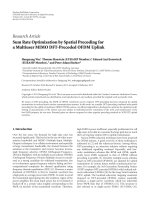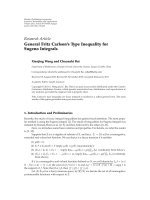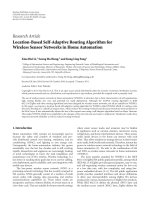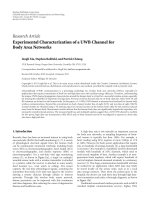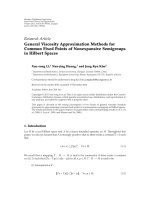Báo cáo hóa học: " Research Article General Fritz Carlson’s Type Inequality for Sugeno Integrals" pptx
Bạn đang xem bản rút gọn của tài liệu. Xem và tải ngay bản đầy đủ của tài liệu tại đây (493.9 KB, 9 trang )
Hindawi Publishing Corporation
Journal of Inequalities and Applications
Volume 2011, Article ID 761430, 9 pages
doi:10.1155/2011/761430
Research Article
General Fritz Carlson’s Type Inequality for
Sugeno Integrals
Xiaojing Wang and Chuanzhi Bai
Department of Mathematics, Huaiyin Normal University, Huaian, Jiangsu 223300, China
Correspondence should be addressed to Chuanzhi Bai,
Received 18 August 2010; Revised 23 November 2010; Accepted 20 January 2011
Academic Editor: L
´
aszl
´
o Losonczi
Copyright q 2011 X. Wang and C. Bai. This is an open access article distributed under the Creative
Commons Attribution License, which permits unrestricted use, distribution, and reproduction in
any medium, provided the original work is properly cited.
Fritz Carlson’s type inequality for fuzzy integrals is studied in a rather general form. The main
results of this paper generalize some previous results.
1. Introduction and Preliminaries
Recently, the study of fuzzy integral inequalities has gained much attention. The most popu-
lar method is using the Sugeno integral 1. The study of inequalities for Sugeno integral was
initiated by Rom
´
an-Flores et al. 2, 3 and then followed by the others 4 –11.
Now, we introduce some basic notation and properties. For details, we refer the reader
to 1, 12.
Suppose that Σ is a σ-algebra of subsets of X,andletμ : Σ → 0, ∞ be a nonnegative,
extended real-valued set function. We say that μ is a fuzzy measure if it satisfies
1 μ∅0,
2 E, F ∈ Σ and E ⊂ F imply μE ≤ μFmonotonicity;
3 {E
n
}⊂Σ, E
1
⊂ E
2
⊂··· imply lim
n →∞
μE
n
μ
∞
n1
E
n
continuity from below,
4 {E
n
}⊂Σ, E
1
⊃ E
2
⊃···, μE
1
< ∞, imply lim
n →∞
μE
n
μ
∞
n1
E
n
continuity
from above.
If f is a nonnegative real-valued function defined on X, we will denote by L
α
f {x ∈
X : fx ≥ α} {f ≥ α} the α-level of f for α>0, and L
0
f {x ∈ : fx > 0} supp f is
the support of f.Notethatifα ≤ β,then{f ≥ β}⊂{f ≥ α}.
Let X, Σ,μ be a fuzzy measure space; by F
μ
X we denote the set of all nonnegative
μ-measurable functions with respect to Σ.
2 Journal of Inequalities and Applications
Definition 1.1 see 1.LetX, Σ,μ be a fuzzy measure space, with f ∈F
μ
X,andA ∈ Σ,
then the Sugeno integral or fuzzy integral of f on A with respect to the fuzzy measure μ is
defined by
A
fdμ
α≥0
α ∧μ
A ∩
f ≥ α
, 1.1
where ∨ and ∧ denote the operations sup and inf on 0, ∞, respectively.
It is well known that the Sugeno integral is a type of nonlinear integral; that is, for
general cases,
af bg
dμ a
fdμ b gdμ 1.2
does not hold.
The following properties of the fuzzy integral are well known and can be found in 12.
Proposition 1.2. Let X, Σ,μ be a fuzzy measure space, with A, B ∈ Σ and f, g ∈F
μ
X;then
1
A
fdμ ≤ μA,
2
A
kdμ k ∧ μA,fork a nonnegative constant,
3 if f ≤ g on A then
A
fdμ ≤
A
gdμ,
4 if A ⊂ B then
A
fdμ ≤
A
fdμ,
5 μA ∩{f ≥ α} ≥ α ⇒
A
fdμ ≥ α,
6 μA ∩{f ≥ α} ≤ α ⇒
A
fdμ≤ α,
7
A
fdμ < α ⇔ there exists γ<αsuch that μA ∩{f ≥ γ} <α,
8
A
fdμ > α ⇔ there exists γ>αsuch that μA ∩{f ≥ γ} >α.
Remark 1.3. Let F be the distribution function associated with f on A,thatis,FαμA ∩
{f ≥ α}.By5 and 6 of Proposition 1.2
F
α
α ⇒
A
fdμ α. 1.3
Thus, from a numerical point of view, the Sugeno integral can be calculated by solving the
equation Fαα.
Fritz Carlson’s integral inequality states 13, 14 that
∞
0
f
x
dx ≤
√
π
∞
0
f
2
xdx
1/4
·
∞
0
x
2
f
2
xdx
1/4
. 1.4
Recently, Caballero and Sadarangani 8 have shown that in general, the Carlson’s
integral inequality is not valid in the fuzzy context. And they presented a fuzzy version of
Fritz Carlson’s integral inequality as follows.
Journal of Inequalities and Applications 3
Theorem 1.4. Let f : 0, 1 → 0, ∞ be a nondecreasing function and μ the Lebesgue measure on
.Then,
1
0
f
x
dμ
x
≤
√
2
1
0
x
2
f
2
xdμx
1/4
·
1
0
f
2
xdμx
1/4
. 1.5
In this paper, our purpose is to give a generalization of the above Fritz Carlson’s
inequality for fuzzy integrals. Moreover, we will give many interesting corollaries of our
main results.
2. Main Results
This section provides a generalization of Fritz Carlson’s type inequality for Sugeno integrals.
Before stating our main results, we need the following lemmas.
Lemma 2.1 see 11. Let X, Σ,μ be a fuzzy measure space, f ∈F
μ
X, A ∈ Σ,
A
fdμ ≤ 1,and
s ≥ 1.Then
A
f
s
dμ ≥
A
fdμ
s
. 2.1
If the fuzzy measure μ in Lemma 2.1 is the Lebesgue measure, then
1
0
fdμ ≤ 1is
satisfied readily. Thus, by Lemma 2.1, we have the following.
Corollary 2.2 see 8. Let f : 0, 1 → 0, ∞ be a μ-measurable function with μ the Lebesgue
measure and s ≥ 1.Then
1
0
f
s
x
dμ
x
≥
1
0
fxdμx
s
. 2.2
Definition 2.3. Two functions f,g : X → R are said to be comonotone if for all x, y ∈ X
2
,
f
x
− f
y
g
x
− g
y
≥ 0. 2.3
An imp o rtant p roperty of comonotone functions is that for any real numbers p, q,either
{f ≥ p}⊂{g ≥ q} or {g ≥ q}⊂{f ≥ p}.
Note that two monotone functions in the same sense are comonotone.
Theorem 2.4. Let X, Σ,μ be a fuzzy measure space, f, g ∈F
μ
X and f and g comonotone
functions, A ∈ Σ with
A
fdμ ≤ 1,and
A
gdμ ≤ 1.Then
A
f ·gdμ ≥
A
fdμ
·
A
gdμ
. 2.4
4 Journal of Inequalities and Applications
Proof. If
A
fdμ 0or
A
gdμ 0 then the inequality is obvious. Now choose α, β such that
1 ≥
A
fdμ > α > 0, 1 ≥
A
gdμ > β > 0. 2.5
Then by 8 of Proposition 1.2,thereexist1>γ
α
>αand 1 >γ
β
>βsuch that
μ
A ∩
f ≥ γ
α
>α, μ
A ∩
g ≥ γ
β
>β. 2.6
As f and g a re comonotone functions, then either {f ≥ γ
α
}⊂{g ≥ γ
β
} or {g ≥ γ
β
}⊂{f ≥ γ
α
}.
Suppose that {f ≥ γ
α
}⊂{g ≥ γ
β
}. In this case, we have the following:
μ
A ∩
fg ≥ γ
α
γ
β
≥ μ
A ∩
f ≥ γ
α
∩
A ∩
g ≥ γ
β
μ
A ∩
f ≥ γ
α
>α≥ αβ.
2.7
Therefore, by applying 8 of Proposition 1.2 again, we find that
A
f ·gdμ > αβ. 2.8
Since the values of α, β > 0 are arbitrary, we obtain the desired inequality. Similarly, for the
case {g ≥ γ
β
}⊂{f ≥ γ
α
} we can get the desired inequality too.
From Theorem 2.4, we get the following.
Corollary 2.5 see 15. Let μ be an arbitrary fuzzy measure on 0,a and f, g : 0,a →
be two
real-valued measurable functions such that
a
0
fdμ ≤ 1 and
a
0
gdμ ≤ 1.Iff and g are increasing (or
decreasing) functions, then the inequality
a
0
f ·gdμ ≥
a
0
fdμ
·
a
0
gdμ
2.9
holds.
If the fuzzy measure μ in Corollary 2.5 is the Lebesgue measure and a 1, then
a
0
fdμ ≤ 1and
a
0
gdμ ≤ 1 are satisfied readily. Thus, by Corollary 2.5,weobtain
Corollary 2.6 see 2. Let f, g : 0, 1 →
be two real-valued functions, and let μ be the Lebesgue
measure on
.Iff, g are both continuous and strictly increasing (decreasing) functions, then the
inequality
1
0
f ·gdμ ≥
1
0
fdμ
·
1
0
gdμ
2.10
holds.
The following result presents a fuzzy version of generalized Carlson’s inequality.
Journal of Inequalities and Applications 5
Theorem 2.7. Let X, Σ,μ be a fuzzy measure space, f, g, h ∈F
μ
X, f and g,andf and h are
comonotone functions, respectively, A ∈ Σ with
A
fdμ ≤ 1,
A
gdμ ≤ 1, ≤
A
hdμ ≤ 1,
A
fgdμ ≤
1,and
A
fhdμ ≤ 1.Then
A
f
x
dμ
x
≤
1
K
A
f
p
x
g
p
xdμx
1/pq
·
A
f
q
xh
q
xdμx
1/pq
, 2.11
where K
A
gxdμx
p/pq
·
A
hxdμx
q/pq
.
Proof. By Lemma 2.1,forp, q ≥ 1, we have the following:
A
fx ·gxdμx
p
≤
A
f
p
x
g
p
x
dμ
x
,
A
f
x
· h
x
dμ
x
q
≤
A
f
q
x
h
q
x
dμ
x
.
2.12
Multiplying these inequalities, we get that
A
fx ·gxdμx
p
·
A
fx ·hxdμx
q
≤
A
f
p
x
g
p
x
dμ
x
·
A
f
q
x
h
q
x
dμ
x
.
2.13
By Theorem 2.4
A
f ·gdμ ≥
A
fdμ
·
A
gdμ
,
A
f ·hdμ ≥
A
fdμ
·
A
hdμ
. 2.14
Substitutes 2.14 into 2.13,weobtain
A
fxdμx
pq
·
A
gxdμx
p
·
A
hxdμx
q
≤
A
f
p
x
g
p
x
dμ
x
·
A
f
q
x
· h
q
x
dμ
x
.
2.15
This inequality implies that 2.11 holds
By Theorem 2.7, we have the following.
Corollary 2.8. Assume that p, q ≥ 1.Letf, g, h : 0, 1 → 0, ∞ are increasing (or decreasing)
functions and μ the Lebesgue measure on
.Thenbe
1
0
f
x
dμ
x
≤
1
K
1
0
f
p
xg
p
xdμx
1/pq
·
1
0
f
q
xh
q
xdμx
1/pq
, 2.16
where K
1
0
gxdμx
p/pq
·
1
0
hxdμx
q/pq
.
6 Journal of Inequalities and Applications
Theorem 2.9. Let g : 0, 1 → 0, ∞ be a μ-measurable f unction with μ the Lebesgue measure. If
g
s
(s ≥ 1) is a convex function such that, g0
/
g1,then
1
0
g
x
dμ
x
≤ min
max
g
0
,g
1
1
g
s
1
− g
s
0
1/s
, 1
. 2.17
Proof. Firstly, we consider the case of g
s
0 <g
s
1.Asg
s
is a convex function, we have by
Theorem 1 of Caballero and Sadarangani 7 that
1
0
g
s
x
dμ
x
≤ min
g
s
1
1 g
s
1
− g
s
0
, 1
. 2.18
By Corollary 2.2 and 2.18,weget
1
0
gxdμx
s
≤ min
g
s
1
1 g
s
1
− g
s
0
, 1
, 2.19
which implies that 2.17 holds. Similarly, we can obtain 2.17 by of 7,Theorem2 for the
case of g
s
0 >g
s
1.
From Theorem 2.9 and Corollary 2.8, we have the following.
Theorem 2.10. Assume that p, q ≥ 1.Letf, g, h : 0, 1 → 0 , ∞ be increasing (or decreasing)
functions and μ the Lebesgue measure on
.Ifg
s
( s ≥ 1)orh
r
( r ≥ 1) is a convex function such that
g0
/
g1 or h0
/
h1,then
1
0
f
x
dμ
x
≤
1
M
p/pq
1
K
q/pq
2
1
0
f
p
xg
p
xdμx
1/pq
·
1
0
f
q
x
h
q
x
dμ
x
1/pq
,
2.20
where
M
1
min
max
g
0
,g
1
1
g
s
1
− g
s
0
1/s
, 1
,K
2
1
0
h
x
dμ
x
, 2.21
or
1
0
f
x
dμ
x
≤
1
K
p/pq
1
M
q/pq
2
1
0
f
p
xg
p
xdμx
1/pq
·
1
0
f
q
xh
q
xdμx
1/pq
,
2.22
Journal of Inequalities and Applications 7
where
K
1
1
0
g
x
dμ
x
,M
2
min
max
{
h
0
,h
1
}
1
|
h
r
1
− h
r
0
|
1/r
, 1
. 2.23
Theorem 2.11. Assume that p, q ≥ 1.Letf, g, h : 0, 1 → 0 , ∞ be increasing (or decreasing)
functions and μ the Lebesgue measure on
.Ifg
s
s ≥ 1 and h
r
r ≥ 1 are two convex functions such
that g0
/
g1 and h0
/
h1,then,
1
0
f
x
dμ
x
≤
1
M
p/pq
1
M
q/pq
2
1
0
f
p
xg
p
xdμx
1/pq
·
1
0
f
q
x
h
q
x
dμ
x
1/pq
,
2.24
where M
1
and M
2
are as in 2.21 and 2.23, respectively .
Straightforward calculus shows that
1
0
x
2
dμ
x
3 −
√
5
2
,
1
0
xdμ
x
1
2
,
1
0
1dμ
x
1. 2.25
If p q 2, gxx and hx1, gxx
2
and hxx, gxx
2
,andhx1,
respectively, then Corollary 2.8 reduces to Theorem 1.4, and the following Corollaries 2.12
and 2.13.
Corollary 2.12. Let f : 0, 1 → 0, ∞ be a nondecreasing function and μ the Lebesgue measure on
.Then,
1
0
f
x
dμ
x
≤
3
√
5
1
0
x
4
f
2
x
dμ
x
1/4
·
1
0
x
2
f
2
x
dμ
x
1/4
. 2.26
Corollary 2.13. Let f : 0, 1 → 0, ∞ be a nondecreasing function and μ the Lebesgue measure on
.Then,
1
0
f
x
dμ
x
≤
6 2
√
5
2
1
0
x
4
f
2
x
dμ
x
1/4
·
1
0
f
2
x
dμ
x
1/4
. 2.27
Remark 2.14. Corollary 2.8 is a generalization of the main result in 8,Theorem1.
If p q 1, gxhxx
2
,thenCorollary 2.8 reduces to the following corollary.
Corollary 2.15. Let f : 0, 1 → 0, ∞ be a nondecreasing function and μ the Lebesgue measure on
.Then
1
0
f
x
dμ
x
≤
3
√
5
2
1
0
x
2
f
x
dμ
x
.
2.28
8 Journal of Inequalities and Applications
Consider gxe
−
√
x1
on 0, 1. This function is nonincreasing g
x
−1/2
√
x 1e
−
√
x1
< 0, nonnegative and convex g
x1/4x 1e
√
x1
1/
√
x 1 1 ≥
0.
Let p q 1, gxhxe
−
√
x1
,ands r 1. As g01/e > 1/e
√
2
g1 and
h0 >h1, we have the following
M
1
M
2
e
√
2−1
e
√
2
e
√
2−1
− 1
. 2.29
Thus, by Theorem 2.11 we can get the following corollary.
Corollary 2.16. Let f : 0, 1 → 0, ∞ be a nonincreasing function and μ the Lebesgue measure on
.Then,
1
0
f
x
dμ
x
≤
e
√
2
e
√
2−1
− 1
e
√
2−1
1
0
e
−
√
x1
f
x
dμ
x
. 2.30
Consider gxx −lnx 1 and hxx −arc tan x on 0, 1. Obviously, g and h are
nonnegative, nondecreasing and convex on the interval 0, 1.Lets r 1, then, we have
the following:
M
1
min
max
g
0
,g
1
1
g
s
1
− g
s
0
1/s
, 1
1 −ln 2
2 −ln 2
,
M
2
min
max
{
h
0
,h
1
}
1
|
h
r
1
− h
r
0
|
1/r
, 1
4 −π
8 −π
.
2.31
Thus, by Theorem 2.11 set p q 1 we can get the following corollary.
Corollary 2.17. Let f : 0, 1 → 0, ∞ be a nondecreasing function and μ the Lebesgue measure on
.Then,
1
0
f
x
dμ
x
≤
2 −ln 2
8 −π
1 −ln 2
4 −π
1
0
x − ln
x 1
fxdμx
1/2
×
1
0
x − arctanx 1fxdμx
1/2
.
2.32
Consider gx
x
2
x 1/8on0, 1. Obviously, this function is nonnegative, non-
decreasing g
x2x 1/2x
2
x 1/8
−1/2
≥ 0, and nonconvex g
x−1/8x
2
x 1/8
−3/2
≤ 0.Butg
2
xx
2
x 1/8isconvex.Sets 2, then we obtain
M
1
17/8
1
17/8 −
1/8
2
2
√
34
√
8
√
17 − 1
2
. 2.33
Journal of Inequalities and Applications 9
Thus, by Theorem 2.10 set g
x
2
x 1/8, hxx, s 2, p 1,q 2 we can get
the following corollary.
Corollary 2.18. Let f : 0, 1 → 0, ∞ be a nondecreasing function and μ the Lebesgue measure on
.Then
1
0
f
x
dμ
x
≤
√
34
√
8
√
17 − 1
2
17
1/3
1
0
x
2
x
1/8
fxdμx
1/3
×
1
0
x
2
f
2
xdμx
2/3
.
2.34
Acknowledgments
The authors would like to thank the referees for reading this work carefully, providing
valuable suggestions and comments. This work is supported by the National Natural Science
Foundation of China no. 10771212.
References
1 M. Sugeno, Theory of fuzzy integrals and its applications, Ph.D. Dissertation, Tokyo Institute o f
Technology, 1974.
2 A. Flores-Franuli
ˇ
candH.Rom
´
an-Flores, “A Chebyshev type inequality for fuzzy integrals,” Applied
Mathematics and Computation, vol. 190, no. 2, pp. 1178–1184, 2007.
3 H. Rom
´
an-Flores, A. Flores-Franuli
ˇ
c, and Y. Chalco-Cano, “A Jensen type inequality for fuzzy
integrals,” Information Sciences, vol. 177, no. 15, pp. 3192–3201, 2007.
4 R. Mesiar and Y. Ouyang, “General Chebyshev type inequalities for Sugeno integrals,” Fuzzy Sets and
Systems, vol. 160, no. 1, pp. 58–64, 2009.
5 H. Rom
´
an-Flores, A. Flor es-Franuli
ˇ
c, and Y. Chalco-Cano, “A Hardy-type inequality for fuzzy
integrals,” Applied Mathematics and Computation, vol. 204, no. 1, pp. 178–183, 2008.
6 H. Agahi, R. Mesiar, and Y. Ouyang, “ General Minkowski type inequalities for Sugeno integrals,”
Fuzzy Sets and Systems, vol. 161, no. 5, pp. 708–715, 2010.
7 J. Caballero and K. Sadarangani, “Hermite-Hadamard inequality for fuzzy integrals,” Applied
Mathematics and Computation, vol. 215, no. 6, pp. 2134–2138, 2009.
8 J. Caballero and K. Sadarangani, “Fritz Carlson’s inequality for fuzzy integrals,” Computers and
Mathematics with Applications, vol. 59, no. 8, pp. 2763–2767, 2010.
9 H. Rom
´
an-Flores, A. Flores-Franuli
ˇ
c, and Y. Chalco-Cano, “The fuzzy integral for monotone
functions,” Applied Mathematics and Computation, vol. 185, no. 1, pp. 492–498, 2007.
10 H. Rom
´
an-Flores, A. Flores-Franuli
ˇ
c, and Y. Chalco-Cano, “A convolution type inequality for fuzzy
integrals,” Applied Mathematics and Computation, vol. 195, no. 1, pp. 94–99, 2008.
11 J. Caballero and K. Sadarangani, “A Cauchy-Schwarz type inequality for fuzzy integrals,” Nonlinear
Analysis. Theory, Methods and Applications. Series A, vol. 73, no. 10, pp. 3329–3335, 2010.
12 Z. Wang and G. Klir,
Fuzzy Measure Theory, Plenum Pr ess, New York, NY, USA, 1992.
13 F. Carlson, “Une ineqalite,” Arkiv f
¨
or Matematik, vol. 25, pp. 1–5, 1934.
14 G. H. Hardy, “A note on two inequalities,” Journal of the London Mathematical Society, vol. 11, pp. 167–
170, 1936.
15 Y. Ouyang, J. Fang, and L. Wang, “Fuzzy Chebyshev type inequality,” International Journal of
Approximate Reasoning, vol. 48, no. 3, pp. 829–835, 2008.



